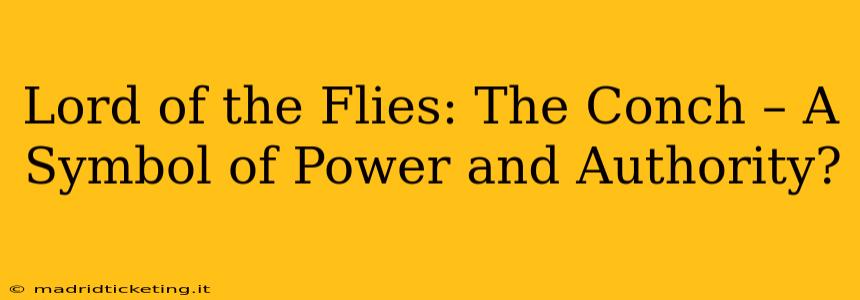William Golding's Lord of the Flies is a chilling exploration of human nature, using symbolism to convey its profound message. One of the most potent symbols in the novel is the conch shell, which initially represents order, civilization, and the potential for democratic governance. However, its significance evolves throughout the story, reflecting the boys' descent into savagery. This essay will delve into the multifaceted symbolism of the conch, exploring its role as a symbol of power and authority, and addressing common questions surrounding its meaning.
What does the conch symbolize in Lord of the Flies?
The conch's symbolism is multifaceted and deeply intertwined with the boys' evolving social structure. Initially, the conch embodies the hope of establishing a civilized society on the deserted island. Ralph's possession of the conch establishes him as the leader, and the act of blowing the conch summons the boys to assembly, implying a democratic process of decision-making. The conch's inherent power lies not in its physical properties but in the boys' collective agreement to its authority. It represents the rule of law, rational discourse, and the possibility of maintaining order amid chaos.
How does the conch's symbolism change throughout the novel?
As the boys' descent into savagery accelerates, the conch's symbolism gradually deteriorates. The conch's power begins to wane as Jack's tribalism and the allure of primal instincts gain influence. The boys' increasing disregard for the conch's authority mirrors the erosion of their civilized behavior. The eventual shattering of the conch marks a definitive turning point, signifying the complete collapse of their attempts at maintaining order and the triumph of savagery. It symbolizes the fragility of civilization and the ease with which it can be overtaken by primal urges.
Does the conch represent democracy in Lord of the Flies?
The conch initially represents a form of democracy, albeit a rudimentary one. The act of blowing the conch to call a meeting, and the agreed-upon rule that only the speaker holding the conch can speak, suggests a semblance of democratic process. However, this democracy is far from perfect. It relies heavily on the boys' willingness to participate and respect the rules, which progressively diminishes as their primal instincts take over. Therefore, while the conch initially symbolizes a democratic ideal, it ultimately demonstrates the limitations and fragility of democracy in the face of unchecked savagery.
What is the significance of the conch's destruction?
The destruction of the conch is a pivotal moment in the novel. It signifies the complete abandonment of reason, order, and civilization. The act of Piggy's death and the conch's simultaneous destruction are inextricably linked. Piggy represents intellect and reason, and his murder alongside the conch's shattering underscores the triumph of brutal force over intellect and civilized discourse. The broken conch symbolizes the boys' complete descent into savagery and the irreversible loss of their potential for a civilized society.
Is the conch a symbol of hope?
The conch initially embodies hope. It represents the boys' initial belief in the possibility of rescue and the establishment of a functioning society on the island. The blowing of the conch is a beacon of hope, a call for unity and cooperation. However, as the novel progresses, this hope dwindles along with the conch's authority. The conch's ultimate destruction symbolizes the extinguishing of this hope, leaving behind only primal instincts and a sense of despair. The initial hope it represented is tragically lost, leaving behind a bleak picture of human nature.
In conclusion, the conch in Lord of the Flies serves as a powerful and multifaceted symbol. It begins as a beacon of hope, representing order, civilization, and a semblance of democracy. However, its significance shifts throughout the narrative, mirroring the boys' descent into savagery. The conch's eventual destruction signifies the complete collapse of their attempts at establishing a civilized society, highlighting the fragility of civilization and the inherent darkness within human nature. Golding masterfully utilizes the conch to deliver a poignant and enduring message about the nature of human society and the ever-present threat of savagery.

